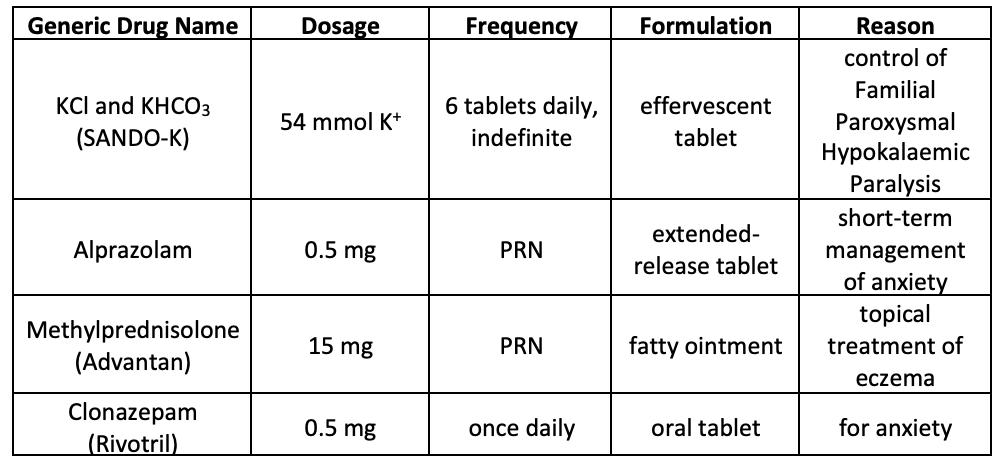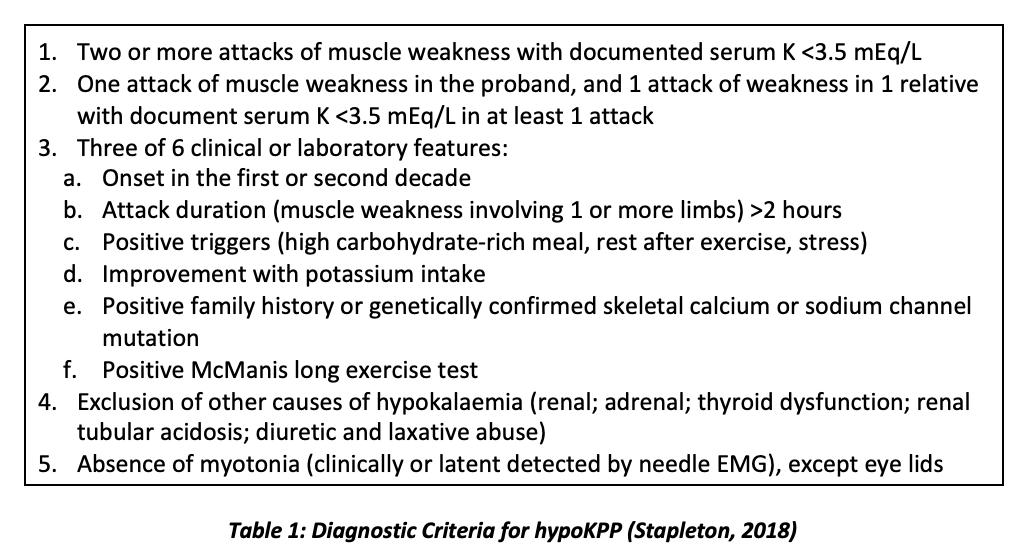
6 minute read
Familial Paroxysmal Hypokalemic Paralysis
Dr. Christian Zammit M.D.,M.Sc.
Advertisement
Tutor
Dr. Malcolm Vella MD, MRCP (UK), FEBN, FRCP (Edin.)
Case Summary:
Demographic Details: Mr. SF, male, South African was referred by his general practitioner
History of Presenting Complaint: The patient occasionally suffers episodes of lower limb weakness. He takes potassium supplements during such episodes and symptoms resolve.
A 26-year-old South African gentleman was referred to the Neurology Outpatient department due to occasional episodes of bilateral muscle weakness in the lower limbs. The attacks last for approximately 1 hour and may result in complete muscle paralysis. The severe attacks of bilateral lower limb paralysis are uncommon. The most severe attack he had ever experienced lasted for 19 hours when he was 19 years of age. Mr. SF noticed that stress, carbohydrate-rich meals and exercise triggered recurrent attacks of muscle weakness. The patient’s grandfather, father and sister have been diagnosed with ‘Familial Paroxysmal Hypokalaemic Paralysis’ (hypoKPP). The father had a positive genetic diagnosis from a muscle biopsy. Mr. SF believes that he has inherited the genetic condition, however, he was never tested for the mutation. When the patient suffers an attack of muscle weakness, he takes potassium supplements and rests at home and symptoms resolve. Presenting Complaint: Mr. SF presented to the Neurology Outpatient department with recurrent episodes of bilateral lower limb weakness and paralysis. The patient’s relatives have been diagnosed with Familial Paroxysmal Hypokalaemic Paralysis. Past Medical and Surgical History: Past Medical History: • anxiety • folliculitis • eczema Past Surgical History: nil Drug History and Allergies: Allergies: Patient is allergic to cortisone injections Family History: Grandfather, father and sister of patient are known to suffer from hypoKPP The father tested positive for a known sequence variant in codon 58 of the CACNA1S gene.
Social History: The patient moved to Malta in 2018. He smokes occasionally, vapes and drinks two beers a week. He is married with no children and has a sedentary job.
Systemic Inquiry: •General Health: patient looks well in general •Cardiovascular System: no abnormalities •Respiratory System: no abnormalities •Gastrointestinal System: no abnormalities •Genitourinary System: no lower urinary tract abnormalities •Nervous System: no abnormalities; bilateral lower limb weakness and paralysis during hypokalaemic episodes only •Musculoskeletal System: no abnormalities •Endocrine System: no abnormalities
On Examination: •Blood Pressure: 105/60 mmHg •Pulse: 70 bpm •CVS: S1 + S2 •chest clear •abdomen: SNT •LL: NAD •ECG: NSR @ 72 bpm
Current Therapy for hypoKPP The patient takes 6 tablets of K + effervescent tablets daily to prevent hypokalaemic episodes.
Neurological Examination: Cranial Nerves: normal. no facial weakness Inspection: no muscle wasting, scars or fasciculations Tone: normal Power: normal Reflexes: normal Coordination: normal Sensation: normal Gait: normal
Differential Diagnosis: •Hypokalaemic Periodic Paralysis (hypoKPP) •Conn’s syndrome •Cushing’s syndrome •Thyrotoxic Periodic Paralysis (TPP)
Diagnostic Procedures:
Laboratory Exams: Test: Referred for genetic testing for CACNA1S gene mutation Justification for test: to confirm the presence of the gene mutation
Diagnosis: Familial Paroxysmal Hypokalaemic Paralysis (hypoKPP)
Final Treatment and Follow Ups: Continue same treatment. Follow up with genetic result.
Fact Box
Title: Familial Paroxysmal Hypokalaemic Paralysis (hypoKPP)
Normal Physiology at the Neuromuscular Junction:
When an action potential reaches the axon terminal at the neuromuscular junction, voltagegated Ca 2+ channels open, allowing Ca 2+ ions to diffuse from the synaptic space into the motor axon. The Ca 2+ ions activate Ca 2+ -calmodulin dependent protein kinase which phosphorylates synapsin proteins, freeing synaptic vesicles from the cytoskeleton in the process (Hall, 2016). The acetylcholine molecules in the synaptic cleft attach to the muscle fibre membrane via acetylcholine-gated ion channels. In turn, the channel undergoes a conformational change, allowing Na + ions to enter the muscle fibre and excite contraction. This action creates an end plate positive potential which gives rise to an action potential. The action potential spreads along the muscle membrane and causes muscle contraction (Hall, 2016).
The usual structure and function of Ca 2+ or Na + channels are altered in hypoKPP. The mutated channels cannot effectively regulate flow of ions into muscle cells, leading to a disruption in ion transport. The ability of skeletal muscles to contract is reduced, giving rise to episodes of weakness and paralysis (Hall, 2016).

Definition and General Overview: Familial Hypokalaemic Paroxysmal Paralysis (hypoKPP) is a relatively rare channelopathy characterised by episodes of flaccid paralysis with concomitant hypokalaemia (serum [K + ] <3.5 mmol/L). HypoKPP is correlated with significant morbidity, but rarely becomes life-threatening (Stapleton, 2018). The frequency of paralytic attacks is highest between age 15 and 35 and eventually decreases as the patient grows older. The duration of these attacks may vary from several hours to days (Statland et al., 2018).
Epidemiology: HypoKPP is an autosomal dominant condition with a prevalence of about 1 per 100,000 individuals. It has 90% penetrance in males and 50% penetrance in females. Indeed, genetic counselling is offered to individuals diagnosed with hypoKPP who are planning to have children (Stapleton, 2018).
Signs and Symptoms: The main features of hypoKPP include reduced muscle tone (flaccidity) proximally, normal to decreased deep tendon reflexes and bilateral muscle weakness during hypokalaemic episodes (Stapleton, 2018). Causes: HypoKPP is mainly caused by pathogenic variants in the CACNA1S or SCN4A genes. In healthy subjects, these genes code for Ca 2+ and Na + ion channels respectively. It is estimated, however, that the associated genes are normal in 30% of hypoKPP patients (Statland et al., 2018).
In a study conducted by M. Castañeda et al., a missense mutation in the ATP1A2 gene was noted in a patient diagnosed with hypoKPP who had normal CACNA1A and SCN4A genes. This gene codes for the 2 subunit of the Na + / K + -ATPase pump expressed in skeletal muscle cells and in brain astrocytes (Castañeda et al., 2018).
Precipitating Factors: The consumption of carbohydrate-rich meals and rest after strenuous exercise are the most common triggers of acute flaccid paralysis due to the release of insulin and K + influx into intracellular spaces, respectively. Other triggers include high-Na + meals, cold temperatures, immobility, alcohol intake, anaesthetic procedures, fear and emotional stress (Stapleton, 2018).
Diagnosis: This is based on the patient’s clinical history, low serum K + levels and family history of the condition (Stapleton, 2018). The diagnosis of hypoKPP is also based on criteria developed by the European Neuromuscular Centre (ENMC) International Workshop. If all four criteria are met, the individual is diagnosed with the channelopathy. It must be noted, however, that failure to satisfy all criteria does not rule out hypoKPP as a possible diagnosis (Stapleton, 2018).

Preventive Management: HypoKPP patients are advised to avoid common triggers, such as strenuous exertion. If avoidance is unsuccessful, prophylactic K + replacement and/or carbonic anhydrase inhibitors are prescribed (Stapleton, 2018). In patients on life-long K + prophylaxis, Mg 2+ supplements promote renal retention of K + ions, thereby enabling a reduction in the K + dose (Statland et al., 2018).
K+ -sparing diuretics are often prescribed to patients who have severe, recurrent attacks and remain unresponsive to carbonic anhydrase inhibitors (Stapleton, 2018).
References:
Abbas Jowkar, MD William D Goldenberg M & Aashit K Shah, MD, FAAN F (n.d.). Neuromuscular Junction. Aug 27, 2018. Available at: https://emedicine.medscape.com/ article/1171206-overview [Accessed January 5, 2020].
Castañeda MS, Zanoteli E, Scalco RS, Scaramuzzi V, Caldas VM, Reed UC, Da Silva AMS, O’Callaghan B, Phadke R, Bugiardini E, Sud R, McCall S, Hanna MG, Poulsen H, Männikkö R & Matthews E (2018). A novel ATP1A2 mutation in a patient with hypokalaemic periodic paralysis and CNS symptoms. Brain 141, 3308–3318.
Hall J. (2016). Secretion of Acetylcholine by Nerve Terminals. In Guyton and Hall Textbook of Medical Physiology, Thirteenth., pp. 89–91. Elsevier.
Stapleton LJ (2018). Hypokalaemia periodic paralysis. Scott Med J 63, 28–31.
Statland JM, Fontaine B, Hanna MG, Johnson NE, Kissel JT, Sansone VA, Shieh PB, Tawil RN, Trivedi J, Cannon SC & Griggs RC (2018). Review of the Diagnosis and Treatment of Periodic Paralysis. Muscle and Nerve 57, 522–530.

Gabriella Debono 3rd Year Medical Student at the Faculty of Medicine & Surgery, University of Malta.










